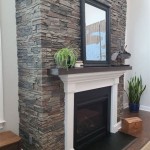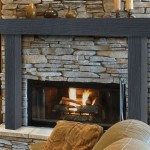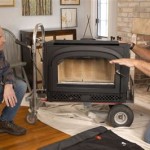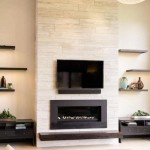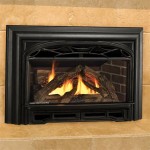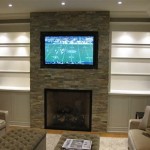Can You Put A Gas Fireplace On An Interior Wall?
The question of whether a gas fireplace can be installed on an interior wall is a common one for homeowners considering adding the ambiance and warmth of a fireplace to their living space. While the traditional image of a fireplace often involves an exterior wall with a chimney, the versatility of modern gas fireplace technology allows for installation in a wider range of locations, including interior walls. However, several factors must be carefully considered to ensure a safe and compliant installation.
The location of a gas fireplace is governed by local building codes, manufacturer specifications, and safety regulations. These factors collectively dictate the feasibility and requirements for installing a gas fireplace on an interior wall. Understanding these aspects is crucial for a successful and safe installation.
Venting Requirements for Interior Wall Gas Fireplaces
The primary challenge of installing a gas fireplace on an interior wall lies in venting the combustion byproducts, primarily carbon monoxide and water vapor, safely and efficiently. Traditional wood-burning fireplaces rely on a vertical chimney to exhaust these gases. However, gas fireplaces offer more flexible venting options, including direct vent and vent-free models. Understanding the differences between these options is key to deciding if an interior wall installation is possible.
Direct vent gas fireplaces are a popular choice for interior wall installations. These fireplaces utilize a sealed combustion system, drawing air from outside the home for combustion and exhausting the combustion gases directly outside through a dual-pipe system. These pipes can be run horizontally through the wall and then up the exterior of the building, or sometimes even terminated directly through the wall, depending on the model and local regulations. Direct vent systems offer increased safety and efficiency compared to traditional fireplaces because they do not draw air from the room, preventing drafts and minimizing heat loss.
Vent-free gas fireplaces, also known as ventless fireplaces, do not require any venting to the outside. They are designed to burn gas very cleanly, minimizing the production of harmful byproducts. However, vent-free fireplaces are subject to stricter regulations and may not be permitted in all jurisdictions. Furthermore, they release a small amount of water vapor into the room, which can contribute to humidity issues if the space is not adequately ventilated. It's imperative to consult with local building codes and a qualified HVAC professional to determine if vent-free fireplaces are allowed and appropriate for a specific location. Many jurisdictions that allow vent-free models often impose restrictions on the size of the fireplace and the amount of time it can be operated continuously.
Another venting option is the B-vent system. B-vent fireplaces use a chimney or vent to exhaust combustion gases, but unlike traditional chimneys, B-vents are typically made of lightweight, double-walled metal. While these systems can be used in interior wall installations, they often require more extensive construction to accommodate the vent’s vertical rise to the roof. This can be a more complex and potentially more expensive option compared to direct vent systems.
Gas Line Installation and Safety Considerations
Another critical aspect of installing a gas fireplace on an interior wall is the gas line connection. A qualified and licensed gas fitter or plumber must install the gas line to ensure it meets all safety regulations and local codes. The gas line should be properly sized to provide adequate gas pressure to the fireplace and must be leak-tested to prevent gas leaks.
The location of the gas line is important. It should be installed in a way that minimizes the risk of damage from everyday activities, such as hanging pictures or moving furniture. Concealing the gas line within the wall is often preferred for aesthetic purposes, but it's important to ensure that the line remains accessible for future maintenance or repairs. Check with local codes regarding gas line concealment specifics.
Carbon monoxide detectors are essential safety devices that should be installed near any gas-burning appliance, including gas fireplaces. These detectors will alert residents to the presence of carbon monoxide, a colorless and odorless gas that can be fatal. Regular inspection and maintenance of the gas fireplace and its venting system are crucial to ensure safe operation and prevent carbon monoxide poisoning.
Wall Construction and Clearances
Wall construction plays a significant role in determining the suitability of an interior wall for a gas fireplace installation. The wall must be structurally sound and capable of supporting the weight of the fireplace. Reinforcement may be necessary, depending on the fireplace model and the wall’s existing construction. Also, combustible materials near the fireplace must be protected from excessive heat.
Clearances to combustible materials are specified by the fireplace manufacturer and outlined in building codes. These clearances dictate the minimum distance that combustible materials, such as wood framing, drywall, and furniture, must be from the fireplace and its venting system. These clearances are designed to prevent fires and ensure the safe operation of the fireplace. Non-combustible materials, such as cement board or metal studs, may be used to reduce required clearances, but must be installed correctly and in accordance with the manufacturer's instructions and local codes.
Furthermore, consider the existing wiring and plumbing within the wall cavity. Gas fireplaces require electrical connections for the igniter, blower, and other components. Careful planning is needed to avoid conflicts with existing utilities and to ensure that all electrical work is performed by a qualified electrician in accordance with electrical codes.
Finally, aesthetic considerations also matter. While technically feasible, an interior wall installation should aesthetically integrate into the overall design of the room. Positioning, facing, and surround materials should be selected to create a visually pleasing focal point that enhances the space.

Can You Install A Gas Fireplace On Interior Wall Just Log Fires
Have Your Fire Wherever You D Like Heatilator
Types Of Fireplaces To Consider When Remodeling An Existing Home Degnan Design Build Remodel
Have Your Fire Wherever You D Like Heatilator

Hole In The Wall Installation Guide Direct Fireplaces

How To Install A Gas Fireplace With Tile Surround And Wood Mantel Sima Spaces

7 Fireplace Surround Ideas That Will Ignite The Room

Can Gas Fireplaces Be Installed On Interior Walls Ehow

How To Modernize And Update A Gas Fireplace We Love Fire

Can You Put Shiplap Around A Fireplace


